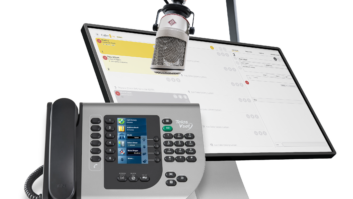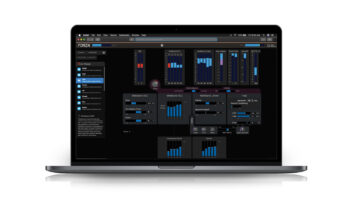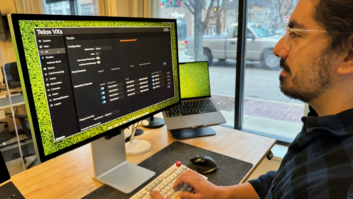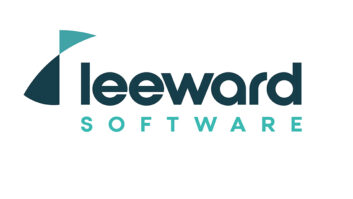(click thumbnail)Denny SandersQ. Telos Systems is showing its Zephyr/IP at NAB. What does it do that radio engineers can’t already do with systems they have?
A. Broadcast codec intended for IP application needs to be optimized for that purpose. The Zephyr/IP’s default codec is the new MPEG AAC-ELD (Enhanced Low Delay) codec. This codec features expanded error concealment that works cleverly with packet loss — up to 20% packet loss — as is sometimes found on typical shared-bandwidth IP connections. Then, using both Low Delay and Spectral Band Replication techniques, the AAC-ELD codec provides reasonably good fidelity down to 24 kbps and excellent fidelity at 64 kbps and higher. This is a good match to the needs of shared IP networks, since they vary so widely.
More importantly, the AAC-ELD codec can “gearshift” its bitrate without audible glitches. Coupled with the Zephyr/IP’s Agile Connection Technology, both initial setup and ongoing path management are automatic, always seeking the highest quality audio with the lowest possible latency.
The most helpful feature of the Zephyr/IP is its automatic NAT-Router traversal, allowing peer-to-peer IP connections through routers over which the user has no control — such as an advertiser’s store. A central rendezvous server — a “Z/IP” server — accepts an auto login from each Zephyr/IP, and displays on the Zephyr/IP a list of other units to which it can connect. This works much like any instant messaging program’s “buddy list”; just highlight the studio you want and click “Call.”
Q. What are the most current coding algorithms available; and what do users need to know about them to choose a codec intelligently?
A. The newest coding algorithms are variations and extensions of MPEG AAC. These include AAC-ELD and AAC-HE (AAC+). These newest codecs offer the best quality, especially at low bit rates. At bitrates of 128 kbps and over, AAC and its variants are judged to be “indistinguishable from the source.”
If bandwidth or storage is nearly unlimited, then PCM linear transmission or storage are recommended.
Q. Your company has been a prime mover in getting IP integrated into broadcast facilities. Where are we on the education and growth curve?
A. Many engineers are getting comfortable with audio-over-IP; over 1,000 radio and audio facilities are using purely standard, Ethernet/IP for routing and/or mixing of studio, production, and program audio.
We’re still helping users understand differences in IP-audio applications — unbuffered, linear IP-audio in studio routing and mixing applications, as in Axia’s Livewire, vs. buffered, coded IP-audio for use over typical WAN or Internet connections. Both linear and coded IP-audio have applications in live studio, remote, STL and program distribution. The transport requirements for unbuffered, linear IP-audio (such as Livewire), though off-the-shelf, are stringent; transport requirements for coded audio are less exacting. Excellent performance over the public Internet is possible when the equipment employs advanced error concealment and automatic bit rate adjustment, as with the Zephyr/IP.
New products will help engineers with program distribution over WANs and even across the public Internet. Wireless options are popping up, including WiFi, EVDO and UMTS compatible systems. These wireless options place more importance on the error concealment available with the AAC-based codecs.
Q. Talk about interoperability. How well do various IP products talk to each other? Are standards developing?
A. The European Broadcasting Union (EBU) has established the N/ACIP (Norm/Audio Codec over IP) standard. This establishes both required and recommended codecs to be available in coding equipment or software systems. Key to interoperability is the use of SIP for call set-up and SDP for codec description, offering automatic codec negotiation.
Missing from the N/ACIP standard is a requirement for codecs with error concealment. Thus, it appears that the standard assumes a QoS-enabled transmission path between compliant codecs. Many broadcasters will want to make sure their codec equipment goes beyond the N/ACIP standard, if they intend to use the public Internet as a transport path.
Q. What other new products or services do you offer for radio broadcasters?
A. The new Zephyr/IP, the Z/IP, is getting spectacular reviews for rock-solid reliability in an IP environment. The Omnia ONE was one of the most successful product introductions in the history of the company. Axia has just introduced Version 2 software for Element, which adds lots of new features to what’s become the fastest-growing brand in broadcasting, with over 1,000 consoles deployed around the world.
Q. What’s the most exciting or unusual project you’ve been involved with lately?
A. One of the most exciting projects is the launch of live, 24/7 365-day technical support on our Axia product line. Because the company has a remarkable amount of former broadcasters on staff, we feel that it is only natural to view the relationship with our clients as more of a partnership when it comes to the integrity of their operation. So we will be there, ready to lend a hand, whenever our Axia clients need us.
Plus, we like to be responsible for breakthrough concepts, and 24/7 live tech support at Axia will be a first among console manufacturers.
Q. Where are you based? Anything else we should know?
A. In the USA, we are based in Cleveland, Ohio, where Steve and Frank started Telos and Omnia after working for Malrite’s WMMS and Z-100 respectively. The two companies merged about 15 years ago. Mike Dosch joined from PR&E about 8 years ago to form the Axia division.
We’ve been active in Europe almost from the start and have both sales and research activities in offices near Munich, Germany and in Riga, Latvia. We’re just now preparing to open an office in Asia.
With the recent Linear Acoustic acquisition, we have around 80 people worldwide. We use manufacturing partners, so all of our people are engaged in research, design, test, support, sales, marketing, finance, and management. If the manufacturing people were to be on our staff, we’d have maybe 140-150 full-time equivalents.
The best thing that I can tell you is that we are driven as individuals to find the smartest and most efficient solutions to our clients’ needs. We have created some of the benchmark products of the industry and will continue to do so.













